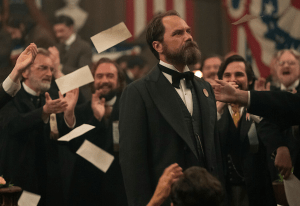John Hughes made more stone-cold classic movies throughout his career than most filmmakers ever have. Very few of even his movies, though, hold as much of a revered and special place in pop culture history as Planes, Trains and Automobiles. The Steve Martin and John Candy-led film is not only one of the most acclaimed American comedies of the 1980s, but it’s also become a perennial Thanksgiving favorite. Every year, plenty of cinephiles pair their Thanksgiving dinners with a welcome rewatch. What some of the film’s fans might not realize, however, is that there was once a three-hour cut of Planes, Trains and Automobiles that, unfortunately, has never seen the light of day.
Videos by ComicBook.com
Indeed, writer-director John Hughes’ constant rewrites resulted in the shooting draft of the script, which is available online, becoming a whopping 165 pages long. The Hollywood shorthand for screenplays is that every page roughly equals one minute of screen time, which means Hughes had put together a version of Planes, Trains and Automobiles over the course of its production that was over twice as long as the finished 92-minute iteration of the film. The movie’s original run time was, consequently, around 3 hours and 45 minutes long.
In an interview with Pro Video Coalition, editor Paul Hirsch described how he and Hughes ended up cutting the film’s run time down in just the five months they had between when principal photography on it wrapped in June 1987 and when it was released in theaters in November of that year. “We actually took out more than we left in,” Hirsch revealed. “We took out a third of the movie in one pass. I turned to John and said, ‘You know, we just cut out 28 days of shooting.’ He just shrugged.”
What Was Cut From the 3-Hour Version?
One of the wonders of Planes, Trains and Automobiles is that it is simultaneously a comedy of endless detours and also one of the tightest, leanest films that Hughes ever made. With that in mind, it may or may not come as a surprise to learn that Hughes excised a lot from the film throughout the editing process. He cut numerous, relatively minor additions, including humorous but unnecessary monologues and jokes. More noteworthy storylines and gags were also cut, though. In Hughes’ original version, for instance, the thief (Gary Riley) who breaks into Del and Neal’s motel room while they’re sleeping was originally introduced as the delivery boy who brings them their pizza and also sets up Neal’s beer explosion by setting the cans on the room’s vibrating bed.
The three-hour version film additionally included a running subplot in which Neal’s wife Susan (Laila Robins) worries that her husband is actually lying to her about his delays to cover up an affair (or affairs). This storyline was eventually abandoned in the edit, but knowing about it adds further context and weight to Susan’s relief and joy when she meets Del at the end of the finished film. Hughes also, notably, cut a climactic Thanksgiving dinner scene at the Pages’ house that was supposed to end the comedy. Traces of it still appear in the final film in the scene when Neal briefly daydreams on the train about getting home before going back to check on Del.
Of all of the movie’s deleted scenes, the most noteworthy may be a train station conversation between Del and Neal. In the theatrical version of Planes, Trains and Automobiles, Del reveals that his wife Marie died eight years before the events of the film and Hughes cuts straight from that to a shot of Neal walking with Del and helping his new friend carry his trunk. Conversely, in Hughes’ original script, Del’s confession is followed by a monologue in which he explains not only the tragic reasons for his vagabond life, but also why he impulsively attached himself to Neal. The written version of this scene is well worth seeking out: It ranks high among the most beautiful and moving things that Hughes ever wrote.
What Happened to the Extended Cut?
An official rendering of Hughes’ original, 225-minute version of Planes, Trains and Automobiles has never been released. There is one, high-quality deleted scene that has been around for years and is often included in TV airings of the film, in which Del discusses his approach to airplane food. This scene, while fairly frivolous, does a good job of communicating the charming, shaggier screwball quality of Hughes’ first, extended cut. VHS-quality recordings of other deleted scenes have made their way into the public eye in recent years as well, thanks to the archives Hughes kept of his work while he was alive.
In an oral history of the film, however, Paramount Pictures’ Bob Buchi told Vanity Fair, “In that era when the film was made, it was really commonplace within the industry to discard all the trims and outs—which is so unfortunate, but it was just the common practice.” For their part, all the remains that the Hughes Estate could find of the film’s original cut were the aforementioned VHS recordings that the filmmaker kept of certain discarded scenes and sequences.
It seems unlikely, therefore, that fans will ever get to see a truly complete and cohesive recreation of Hughes’ original cut of Planes, Trains and Automobiles. That reality doesn’t have to ruin future rewatches of the film, though. Instead, Fans should rejoice the next time they turn on Planes, Trains and Automobiles in knowing that there are countless more moments of humor, heartbreak, and melancholy lurking between its many, carefully planned cuts than they’d previously thought. They might not ever be able to see all of those moments returned to their original places, but they can take comfort in the knowledge that the traces of them are, in many cases, still there in the finished film.
Planes, Trains and Automobiles is streaming now on Paramount+.








